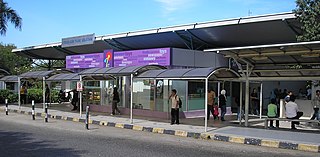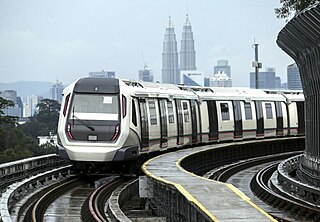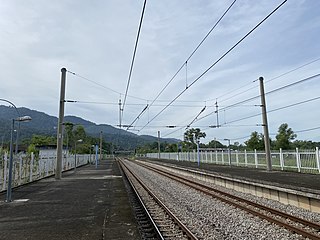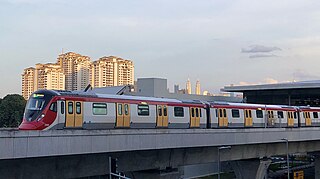Prasarana Malaysia Berhad (Prasarana) (English: Malaysian Infrastructure Limited) is a 100% government-owned company which was set up by Ministry of Finance (Malaysia) as a corporate body established under the Minister of Finance (Incorporation) Act 1957 to own the assets of multi-modal public transport operator in Malaysia, under the government's move to restructure the city's public transport system. It is one of the largest public-transport companies in Malaysia other than Konsortium Transnasional Berhad. As a government-owned company since 1998, it operates stage bus and light metro services via several wholly owned subsidiaries.
Duta–Ulu Klang Expressway, is the main expressway network in Klang Valley, Malaysia. The 18 km (11 mi) expressway connects New Klang Valley Expressway's Jalan Duta Interchange (E1) to Taman Hillview Interchange on Kuala Lumpur Middle Ring Road 2 28 in Ulu Klang. The expressway was constructed to provide the "missing link" between New Klang Valley Expressway (E1), Kuala Lumpur–Karak Expressway (E8), and Kuala Lumpur Middle Ring Road 2 (JKR28). This expressway is also known as the Kuala Lumpur Northeast Dispersal Link Scheme. It was proposed by Tan Sri Datuk Lim Kang Hoo, a chairman of Ekovest Berhad.

Mines Wellness City, formerly known as Mines Resort City, is an integrated Health and Wellness resort township in Seri Kembangan, Selangor, Malaysia.

Rail transport in Malaysia consists of heavy rail, light rapid transit (LRT), mass rapid transit(MRT), monorails, airport rail links and a funicular railway line. Heavy rail is mostly used for intercity services and freight transport as well as some urban public transport, while rapid transit rails are used for intracity urban public transport in the capital city of Kuala Lumpur and the surrounding Klang Valley region. There are two airport rail link systems linking Kuala Lumpur with the Kuala Lumpur International Airport (KLIA) and Sultan Abdul Aziz Shah Airport. The only-functioning monorail line in the country is also used for public transport in Kuala Lumpur, while the only funicular railway line is available in Penang.

Bandar Tasik Selatan station (BTS) is a major Malaysian interchange station located next to and named after Bandar Tasik Selatan, in Kuala Lumpur. The station serves as both a stop and an interchange for the KTM Komuter's Seremban Line, KTM ETS, the LRT Sri Petaling Line, and the Express Rail Link's KLIA Transit trains. BTS is integrated with the Terminal Bersepadu Selatan bus hub (TBS). BTS and TBS are developed as an intermodal transportation hub.
Transport in Greater Kuala Lumpur includes a road network, a railway network, airports, and other modes of public transport. Greater Kuala Lumpur is conterminous with the Klang Valley, an urban conglomeration consisting of the city of Kuala Lumpur, as well as surrounding towns and cities in the state of Selangor. The Klang Valley has the country's largest airport, the Kuala Lumpur International Airport (KLIA), as well as the country's largest intermodal transport hub and railway station, Kuala Lumpur Sentral.

Abdullah Hukum station is an integrated rapid transit station in Kuala Lumpur, Malaysia, served by both the LRT Kelana Jaya Line and the KTM Komuter Port Klang Line.

The Sungai Buloh station is an integrated railway station serving the suburb of Sungai Buloh in Selangor, Malaysia, which is located to the northwest of Kuala Lumpur.

The MRT Kajang Line, previously known as the MRT Sungai Buloh–Kajang Line, is a Mass Rapid Transit (MRT) line servicing the Klang Valley, Malaysia. It is the second fully automated and driverless rail system in the Klang Valley region after the LRT Kelana Jaya Line. Owned by MRT Corp and operated as part of the Rapid KL system by Rapid Rail, it forms part of the Klang Valley Integrated Transit System. The line is numbered 9 and coloured green on official transit maps.

Sri Permaisuri is a township in Cheras, Kuala Lumpur, Malaysia. It is located near Bandar Tun Razak and Salak South. It was opened for residential housing in 2000. The major types of housing there are apartments and condominiums.

Railway electrification in Malaysia is a relatively recent development of rail transport in Malaysia. While the first railway in the country dates back to 1885, it was not until 3 August 1995 that the first electrified railway service, KTM Komuter, began operations.

1Malaysia Development Berhad is an insolvent Malaysian strategic development company, wholly owned by the Minister of Finance (Incorporated).

The Tun Razak Exchange, otherwise known as TRX, is a 70-acre development by Ministry of Finance Malaysia (MOF) in the heart of Kuala Lumpur for international finance and business. The development was named after the second Prime Minister of Malaysia, Tun Abdul Razak Hussein, due to its location along Jalan Tun Razak. TRX is a strategic enabler of the Malaysian government's Economic Transformation Programme (ETP).

The Klang Valley Mass Rapid Transit project is a planned three-line mass rapid transit (MRT) system in the Klang Valley, an urban conurbation in Malaysia which includes the capital city of Kuala Lumpur. The MRT lines, when completed, would be operated as components of the Klang Valley Integrated Transit System.

The MRT Putrajaya Line, is the second Mass Rapid Transit (MRT) line in Klang Valley, Malaysia, and the third fully automated and driverless rail system in the country. It was previously known as the MRT Sungai Buloh–Serdang–Putrajaya Line. The line stretches from Kwasa Damansara to Putrajaya and runs through densely populated areas such as Sri Damansara, Kepong, Batu, Jalan Ipoh, Sentul, Kampung Baru, Jalan Tun Razak, KLCC, Tun Razak Exchange, Kuchai Lama, Seri Kembangan and Cyberjaya.

The BRT Federal Line was a proposed bus rapid transit for Kuala Lumpur–Klang Corridors, and it has been identified in the KL BRT Report 2011 as one of the potential BRT Corridors in the Klang Valley region. The BRT project was planned to be operational by 2018, but is now shelved indefinitely. The government cited "redundancies with the LRT3 " as the reason for its decision to cancel the project.

The Klang Valley Integrated Transit System is an integrated transport network that primarily serves the area of Klang Valley and Greater Kuala Lumpur. The system commenced operations in August 1995 with the introduction of commuter rail service on the existing rail between Kuala Lumpur and Rawang. The system have since expanded and currently consists of 11 fully operating rail lines in a radial formation; two commuter rail lines, six rapid transit lines, one bus rapid transit line and two airport rail links to the Kuala Lumpur International Airport's (KLIA) Terminal 1 and Terminal 2, and one temperarily suspended airport rail link to the Sultan Abdul Aziz Shah Airport. The system encompasses 528.4 kilometres (328.3 mi) of grade-separated route on standard gauge and metre gauge with 197 operational stations.
Lim Kang Hoo is a Malaysian businessman and investor. He is the founder, chairman and chief executive of Iskandar Waterfront Holdings and Ekovest Berhad. Both corporations manage infrastructure construction projects, as well as mega property development. Tan Sri Lim is also linked to other public listed companies in directorial roles; PLS plantations, holding 40,000 acres in palm oil plantations and Knusford Berhad and Tebrau Teguh Berhad.
The Bandar Malaysia railway station is a planned railway station and a high-speed rail terminus as part of the Bandar Malaysia project in the Salak Selatan district in southern Kuala Lumpur, Malaysia.

The Exchange 106, formerly known as the TRXSignature Tower, is a 453.6-meter-tall supertall skyscraper in Kuala Lumpur, Malaysia. It is the second-tallest building in Malaysia and the third-tallest building in Southeast Asia. The 397.3-meter building is topped with an 11-story high illuminated crown, giving it a total height of 453.6 m (1,488 ft). It is also the second largest skyscraper in Malaysia by floor area with 453,835 m2 (4,885,000 sq ft). The tower has a net lettable area of 240,000 square metres. It is also the centerpiece of the new Tun Razak Exchange (TRX) financial district.















